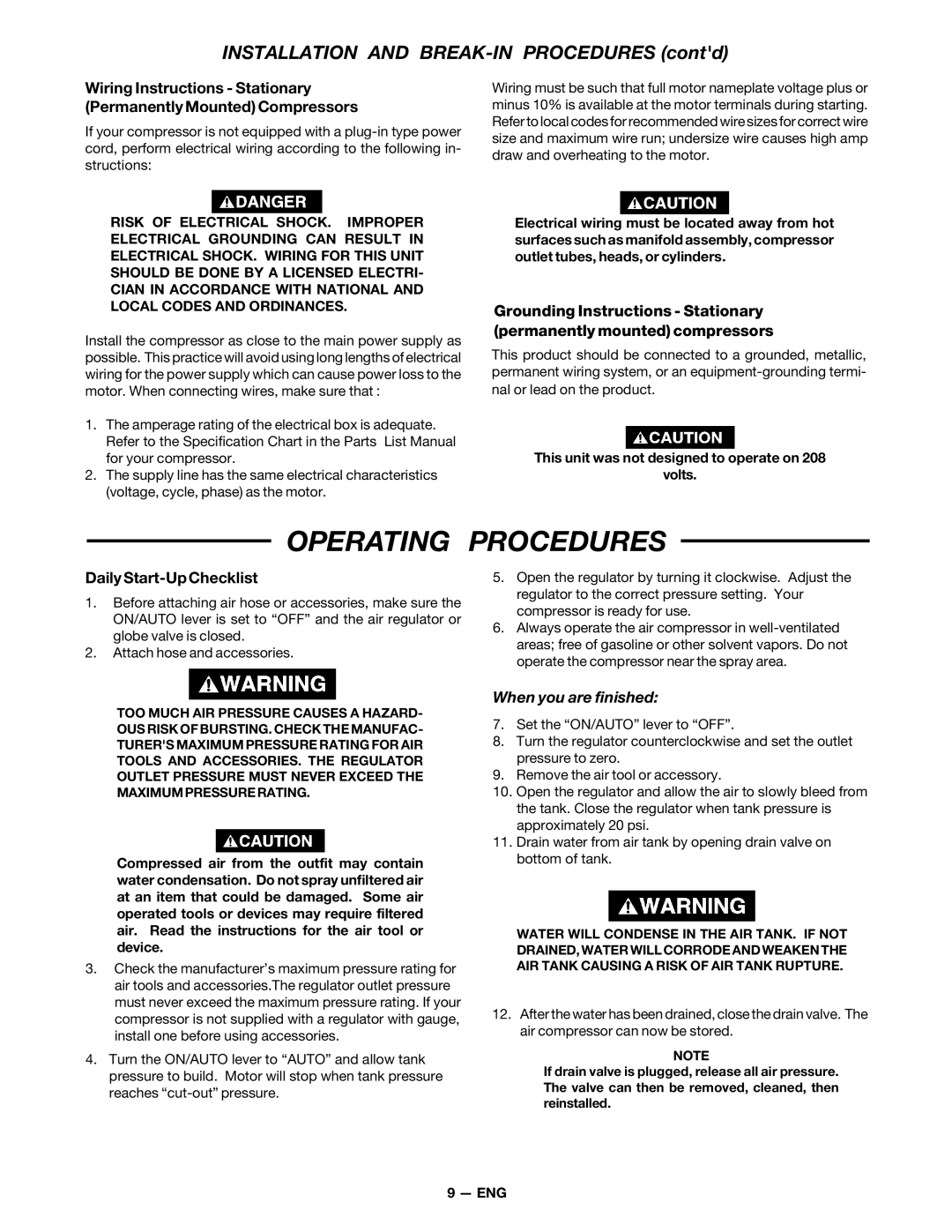
INSTALLATION AND BREAK-IN PROCEDURES (cont'd)
Wiring Instructions - Stationary (Permanently Mounted) Compressors
If your compressor is not equipped with a
RISK OF ELECTRICAL SHOCK. IMPROPER ELECTRICAL GROUNDING CAN RESULT IN ELECTRICAL SHOCK. WIRING FOR THIS UNIT SHOULD BE DONE BY A LICENSED ELECTRI- CIAN IN ACCORDANCE WITH NATIONAL AND LOCAL CODES AND ORDINANCES.
Install the compressor as close to the main power supply as possible. This practice will avoid using long lengths of electrical wiring for the power supply which can cause power loss to the motor. When connecting wires, make sure that :
1.The amperage rating of the electrical box is adequate. Refer to the Specification Chart in the Parts List Manual for your compressor.
2.The supply line has the same electrical characteristics (voltage, cycle, phase) as the motor.
Wiring must be such that full motor nameplate voltage plus or minus 10% is available at the motor terminals during starting. Refer to local codes for recommended wire sizes for correct wire size and maximum wire run; undersize wire causes high amp draw and overheating to the motor.
Electrical wiring must be located away from hot surfaces such as manifold assembly, compressor outlet tubes, heads, or cylinders.
Grounding Instructions - Stationary (permanently mounted) compressors
This product should be connected to a grounded, metallic, permanent wiring system, or an
This unit was not designed to operate on 208
volts.
OPERATING PROCEDURES
Daily Start-Up Checklist
1.Before attaching air hose or accessories, make sure the ON/AUTO lever is set to “OFF” and the air regulator or globe valve is closed.
2.Attach hose and accessories.
5.Open the regulator by turning it clockwise. Adjust the regulator to the correct pressure setting. Your compressor is ready for use.
6.Always operate the air compressor in
TOO MUCH AIR PRESSURE CAUSES A HAZARD- OUS RISK OF BURSTING. CHECK THE MANUFAC- TURER'S MAXIMUM PRESSURE RATING FOR AIR TOOLS AND ACCESSORIES. THE REGULATOR OUTLET PRESSURE MUST NEVER EXCEED THE MAXIMUM PRESSURE RATING.
Compressed air from the outfit may contain water condensation. Do not spray unfiltered air at an item that could be damaged. Some air operated tools or devices may require filtered air. Read the instructions for the air tool or device.
3.Check the manufacturer’s maximum pressure rating for air tools and accessories.The regulator outlet pressure must never exceed the maximum pressure rating. If your compressor is not supplied with a regulator with gauge, install one before using accessories.
4.Turn the ON/AUTO lever to “AUTO” and allow tank pressure to build. Motor will stop when tank pressure reaches
When you are finished:
7.Set the “ON/AUTO” lever to “OFF”.
8.Turn the regulator counterclockwise and set the outlet pressure to zero.
9.Remove the air tool or accessory.
10.Open the regulator and allow the air to slowly bleed from the tank. Close the regulator when tank pressure is approximately 20 psi.
11.Drain water from air tank by opening drain valve on bottom of tank.
WATER WILL CONDENSE IN THE AIR TANK. IF NOT DRAINED, WATER WILL CORRODE AND WEAKEN THE AIR TANK CAUSING A RISK OF AIR TANK RUPTURE.
12.After the water has been drained, close the drain valve. The air compressor can now be stored.
NOTE
If drain valve is plugged, release all air pressure. The valve can then be removed, cleaned, then reinstalled.
9 — ENG
